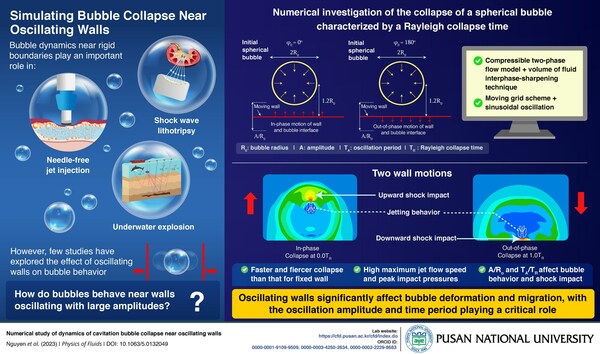The researchers employ a two-phase flow model to study the interface deformation, jetting behavior, and shock impact on bubble dynamics
BUSAN, South Korea, Feb. 10, 2023 /PRNewswire/ — Bubble dynamics plays a significant role in mechanics, chemistry, medicine, and biology. Understanding their interactions with the surrounding walls of the container is crucial for numerous applications, including cavitation erosion, underwater explosion, ultrasonic cleaning, shock wave lithotripsy (for treating kidney stones) and needle-free jet injection. As a result, researchers have explored bubble behavior both experimentally and theoretically (through numerical simulations. However, such studies have largely considered the container walls to be rigid and their findings are inadequate for instances involving oscillating walls – a significantly more complex behavior – such as erosion, cavitation, and microjet flow control.
Addressing this issue, a team of researchers from Vietnam and Korea led by Prof. Warn-Gyu Park from Pusan National University (PNU) in Korea, numerically investigated the collapse of a spherical bubble characterized by a Rayleigh collapse time, TR near a rigid wall oscillating with a large amplitude (greater than one percent of the bubble radius). Their work was made available online on 14 December 2022 and was published in Volume 35, Issue 1 of journal Physics of Fluids on 05 January 2023.
“The bubble collapse was simulated using a compressible two-phase, namely water and vapor, flow model and the volume of fluid interphase-sharpening technique. Further, we used a moving grid scheme and a sinusoidal function to represent the wall oscillations,” explains Mr. Quang-Thai Nguyen, a PhD student at PNU and the first author of the study. “We then verified the predictions of our model against experimental data on bubbles and their dynamics near fixed walls. Following this, the case of oscillating walls were considered.”
In their two-phase model, the researchers simulated the walls as initially moving either towards (in-phase) or away from (out-of-phase) the bubble. While the in-phase wall motion compressed the bubble surface leading to a high internal pressure, the opposite happened in the out-of-phase case. In both cases, however, the bubble collapsed faster and more violently than for the fixed wall scenario. Significant jet formation and higher pressure peaks were also observed. However, the collapse times were different in each case – 0.0 TR for in-phase and 1.0 TR for out-of-phase motion.
Additionally, the researchers determined the effect of the wall oscillation amplitude-to-bubble radius and wall oscillation time period-to-TR ratios on bubble behavior, namely its size, collapse time, and migration, and the wall shock impact, namely the flow speed and impact pressure. The simulation revealed multiple features, including a critical point for the in-phase scenario for an oscillation amplitude-to-bubble radius of 0.5.
While these results are interesting in themselves, they have applications beyond extending the knowledge of bubble-wall interactions. “They will contribute to the development of new technologies in industrial engineering, transferring laboratory-scale applications to commercial-scale operations. For instance, the high values of maximum jet flow speed and peak impact pressures observed in our study could help resolve existing microjet direction and cavitation erosion control problems,” speculates Prof. Park. “Furthermore, the advanced numerical method can be extended to analyze multiphase compressible flows in areas such as renewable energy, life science and biomedicine, and high-velocity projectiles,” he concludes.
Reference
Title of original paper: Numerical study of dynamics of cavitation bubble collapse near oscillating walls
Journal: Physics of Fluids
DOI: https://doi.org/10.1063/5.0132049
About Pusan National University
Website: https://www.pusan.ac.kr/eng/Main.do
Contact:
Jae-Eun Lee
82 51 510 7928
353526@email4pr.com
SOURCE Pusan National University

